The Vineyard’s third hurricane roared over the Island Tuesday, reached the high mark of a flood sea in some places exceeding that of 1938, and left a scene of destruction as the wind abated and the seas fell. The high of the tidal flood came about noon. All the serious damage was inflicted between mid-morning and a little past noon.
No lives were lost, and few personal injuries were attributed to the storm. That was a cause for thankfulness. But property damage was enormous - no reasonable estimate is possible - and the fresh demolition of Menemsha led all the rest.
Trees on the land and boats in the harbors and along the shore suffered the most widespread damage, the shores of the Island were altered, the ponds opened to the sea. Hotels and business places suffered damage and every householder had a certain amount of ruin to clean up.
The 1938 hurricane, so far as the Vineyard was concerned, was a great flood. The 1944 hurricane was a great wind. The 1954 hurricane came with both flood and wind, both forces of cruel damage and destruction. Gusts of ninety-four miles velocity were observed on the anenometer at the Martha’s Vineyard Airport, and the gale was mightiest slang the shore.
Although fishermen and boatmen declared that the rise of tide was not as great as in 1938, the appearance of Bluffs for hours after the storm indicated that It must have risen as high or higher.
Pools of salt water stood in every low spot near the waterfront, and Sunset Lake and the harbor were one, united over New York avenue, until- late afternoon, at least, while boats, large and small, lay along Commercial avenue and even up on the grass many rods Inshore.
More damage and more pools were to the eastward, among the garages and other waterfront business establishments, and no one could say then, or even now, what the damage may total.
Easterly, the town bathhouses suffered extensive damage, and the deck was torn off the pier. A large hole was breached in the seawall and a new garage, recently built at Cluster Village, completely disappeared, and the car which it held was nearly covered with water. All the houses fronting on Ocean Park suffered damage from the wind, and Harthaven likewise suffered wind and water damage, while the beach drive beyond was impassable, first because of water, and later because of drifted sand and damage to the road itself.
Many trees were uprooted, all aver the town, and several garages and small buildings were literally torn to pieces. Sunset Lake spread as far as School street to the south, and the harbor flooded the village to include the square at the foot of Circuit avenue to a depth of at least four feet. so that an outboard motorboat was careering around in the square itself.
Family Is Evacuated
The home of the Leslie Allens next to the school gym, had Its roof torn off, and the police headed by Chief Herbert Combra, evacuated the family, including six children and an elderly woman.
At Eastville, the sea came in across the road, breaking against the fronts of the houses that line the harbor, and smashing in most of them. Families occupying them had to leave, and the police, striving to give assistance, were cut off with their cars by rising water, being obliged to push the vehicles to safety.
The road itself was buried several feet deep with sand, rocks and wreckage, and the surfacing is probably broken and ruined to a high degree. An idea of the height of the water may be gained from the fact that the home of Bradford Church was completely surrounded, and the woods are full of rowboats, according to Chief Combra.
Beach Road, between Oak Bluffs , and Vineyard Haven, was deeply flooded in places, and hours after the alarm the mass of wreckage,. Including cars and parts of the cars, tree: atitmps and -other items, .littered the road, massed againit the sea-wall, and the weight of stumps and wreck-- age toppled many rods of the heavy guard-rail.
The front of at least one of the Martha’s Vineyard Shipyard storage sheds was crushed in, sections of metal roofing were scattered by the wind, and the whole place was flooded, with resultant loss of material, equipment and tools.
Water continued to flood the road toward Vineyard Haven, and the various business places were flooded more or less by the rising of Lagoon Pond. Vineyard Villa reported water damage.
A Heart-Rending Scene
Three large cabin cruisers, moored to the town pier, rode up over the spilling and fouled, one being stove and sunk early in the forenoon. One sloop struck on the breakwater, and ground and pounded for a long time before she was cleared, for owners and volunteer help worked manfully to prevent damage at the risk of drowning or being blown into the water from piers or docks.
All along the shore fragments and fixtures of the stranded yachts, small boats and wreckage, was strewn in windows, and the storm tide, though not as high by far as the hurricane tidal wave of 1938, ran up into boat-yards, garages and other waterfront buildings, causing tremendous water damage and floating away valuable property of various kinds.
The West Chop dock was seriously damaged, and undoubtedly other piers along the harbor shore suffered even more. Thousands of tree limbs were torn off to partially barricade streets and roads, and even blocked garage doors and driveways. A number of the larger trees in the village fell, with roots torn from the ground by the weight of wind in branches laden with foliage.
Signs, shingles, bricks and other objects, flew like shrapnel before the wind, and the Vineyard Boatyard, where workmen were replacing corrugated iron roofs, great sheets of this metal were tossed about like kites, menacing everything in the road and the nearby vicinity.
Up to something past noontime the storm was comparable with the “August blow” of 1924 and in many respects the action of the storm and the damage caused, paralleled that of the blow of that year. The barometer did not, up to 12.25, drop as in the other hurricanes, nor did it reveal by vibration of the needle the lowering of atmospheric pressure noticeable in both hurricanes. The barometer started to rise at about 1 p.m. and was 29.3 at 1:35.
How It Differed
Differing too from either of the earlier hurricanes was the longer build-up and continuance of the heavy wind. Actually, much of the damage noted in Vineyard Haven harbor among the boats was the long-continued blows upon the anchored craft by wind and sea. Cables simply could not stand the prolonged yanking and even chains parted.
The loss of electric power early in the day, due for the most part to falling tree limbs, created a run on the stores which carried candles, Sternolamps, kerosene lamps and flashlight batteries. Markets, some of which are mainly dependent upon electric saws and slicers, were obliged to refuse to fill meat orders for a time, having no knives or saws to operate by hand.
The Nantucket steamer came through without mishap and remained at Woods Hole, the ferry also riding out the storm at that port after making its 6 and 8:15 trips. Fears were felt for the safety of the ferry because of the danger of the high tide floating her above the spiles.
Both the Oak Bluffs and Vineyard Haven steamboat docks had to be abandoned before the tide had risen long, the ticket office windows at Oak Bluffs being under water at half-tide and the Vineyard Haven office being drowned out somewhat later. Cash was banked, but nothing could be done about the freight, the docks being under water and impassable to vehicles.
Two Island Fishermen, the Roann, Roy Campbell master, of Vineyard Haven, and the Christine and Dan, Capt. Bjarne Larson of Chilmark, were both somewhere on Georges Bank during the storm, but being large craft, capable of running for deep water, they were expected to ride out the storm with no more than normal difficulty.
The funniest touch of humor in a tragic situation was the frantic request from the owner of a yacht ashore to Robert Goodale to come at once with a bulldozer and float his yacht!

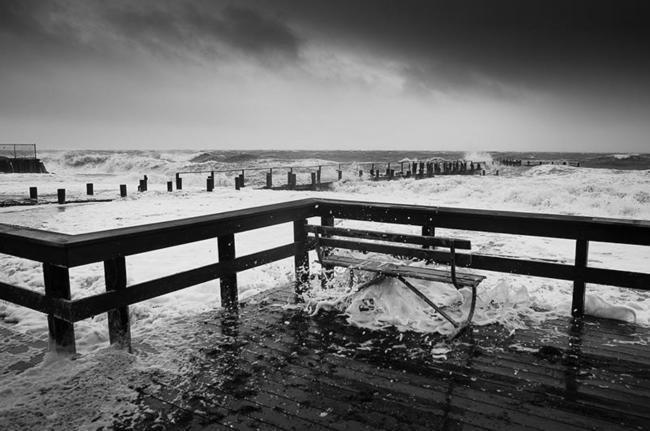



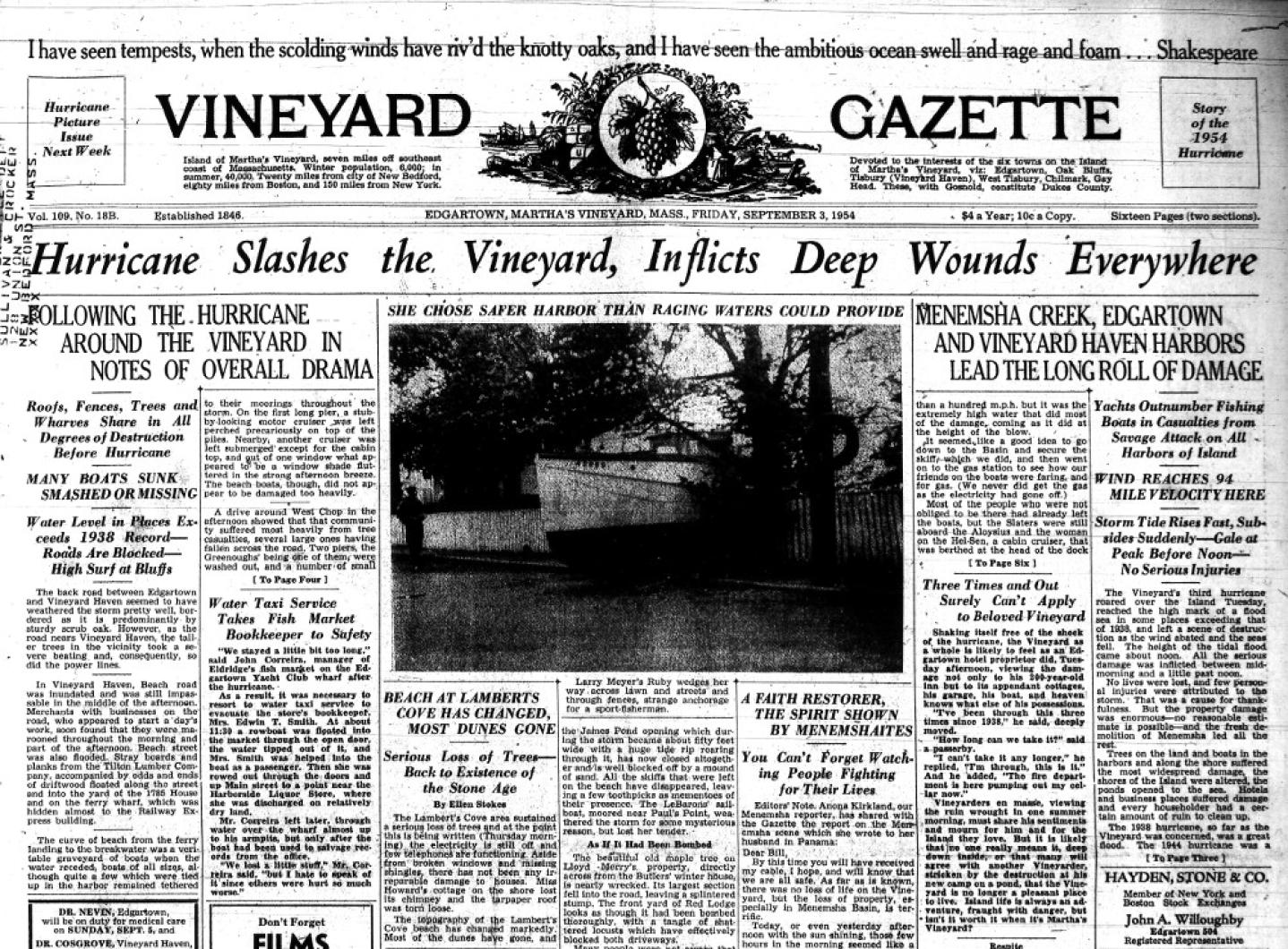
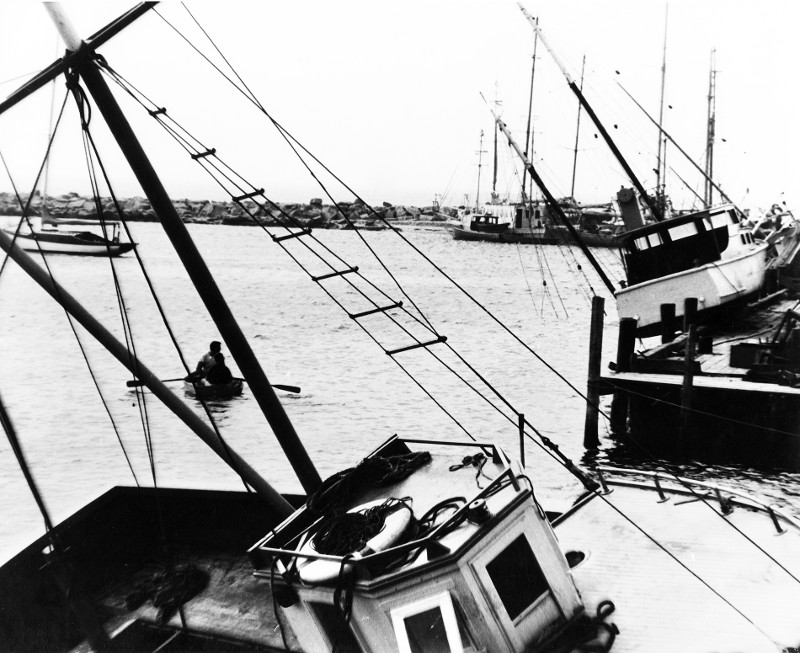
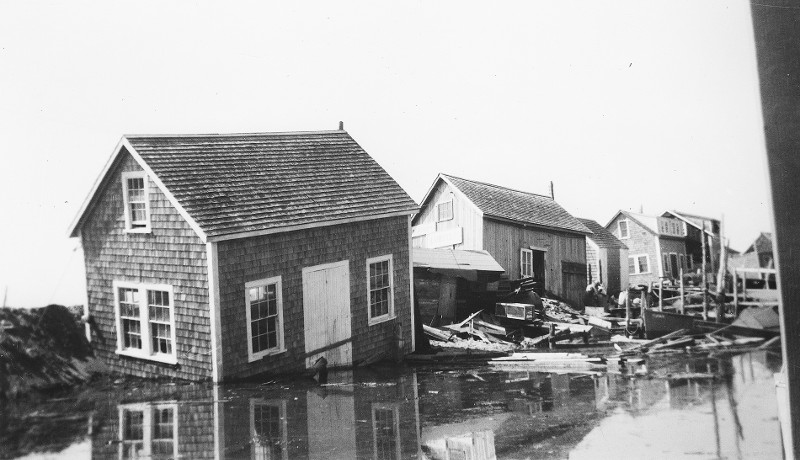
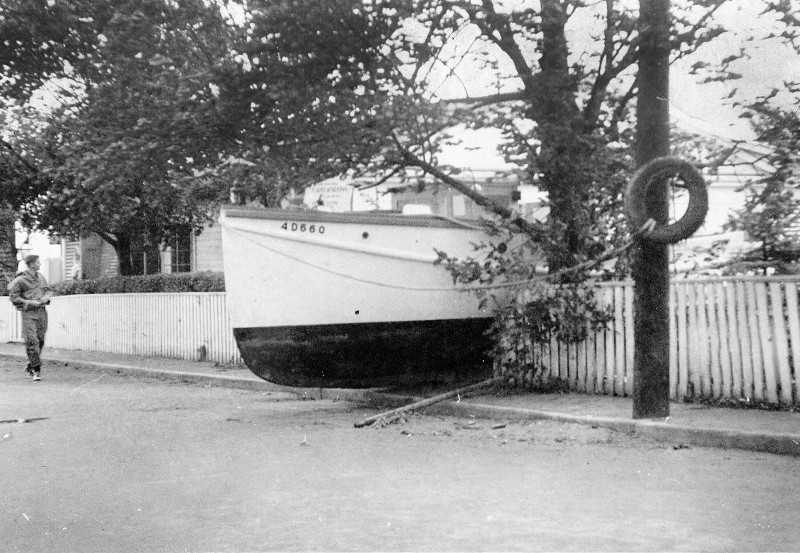

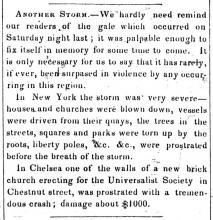
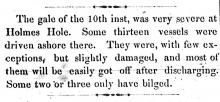

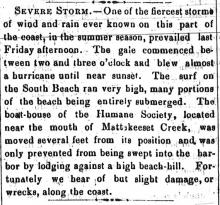
Comments